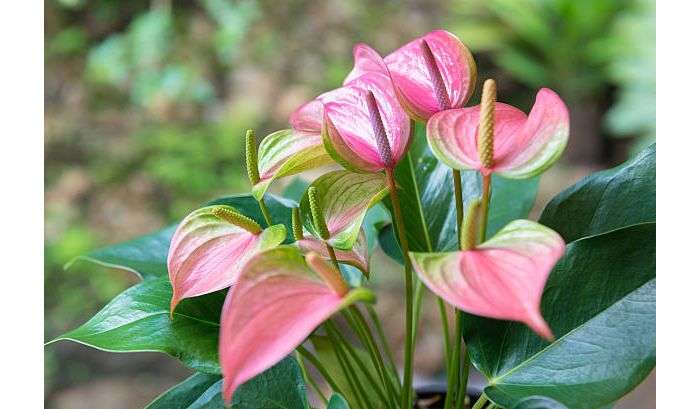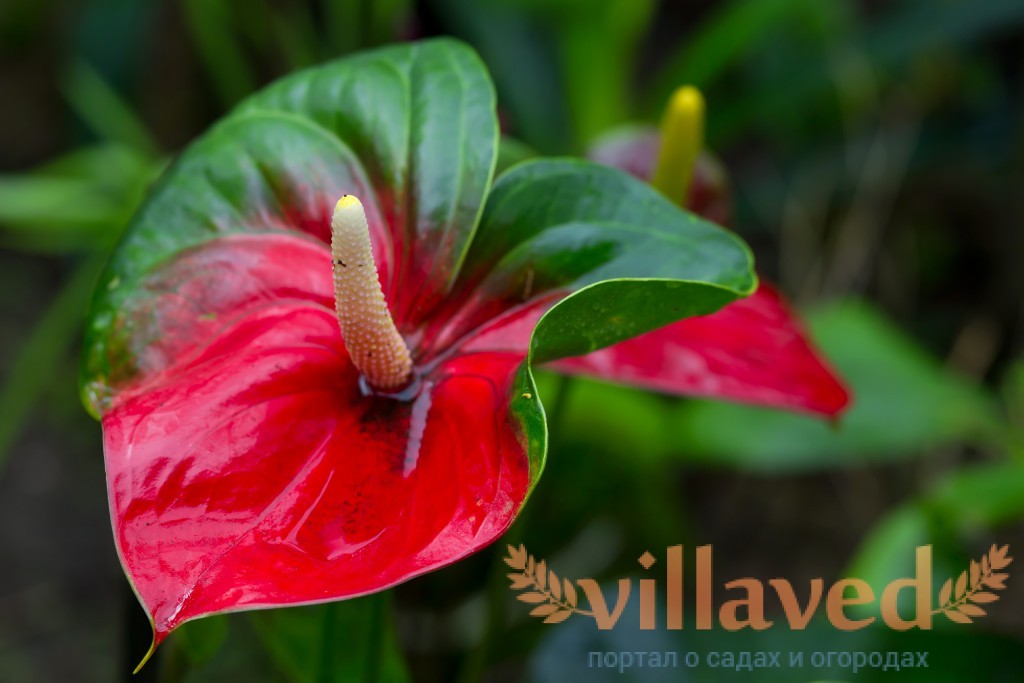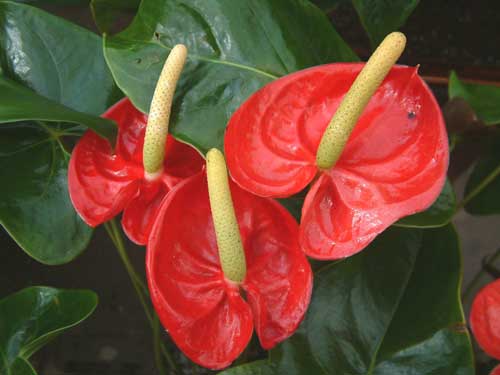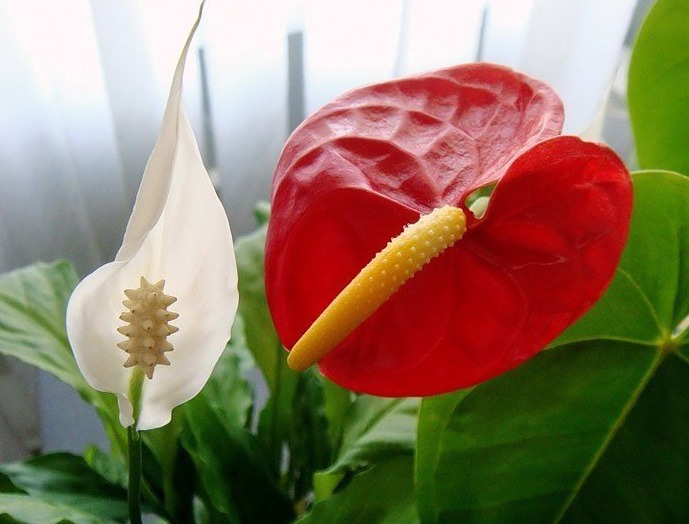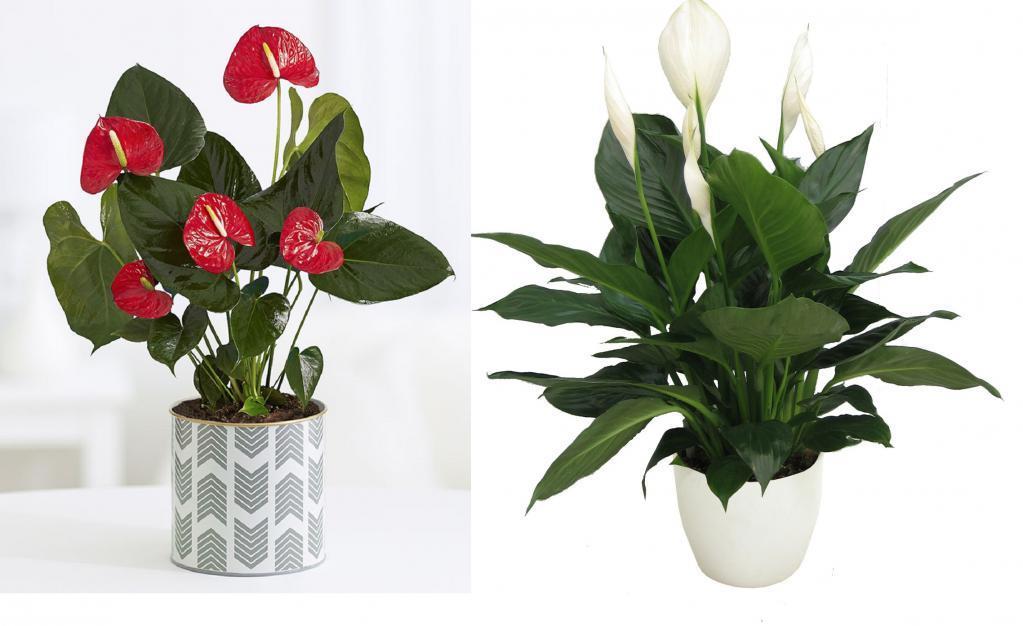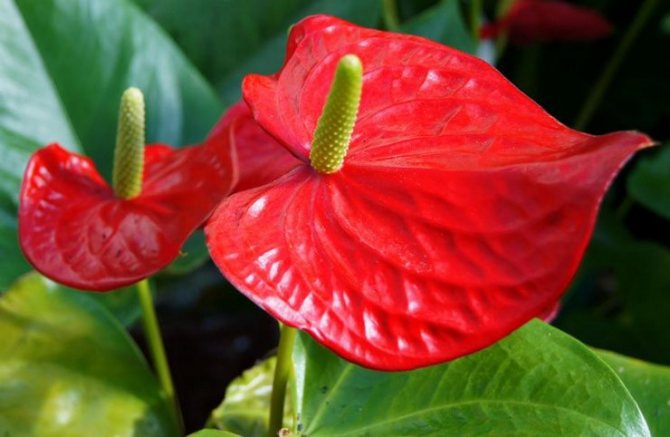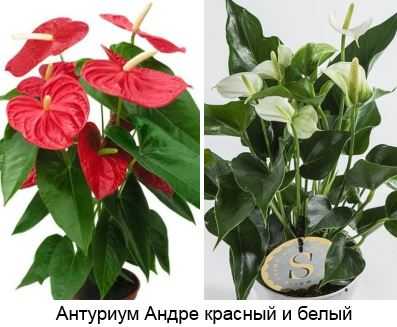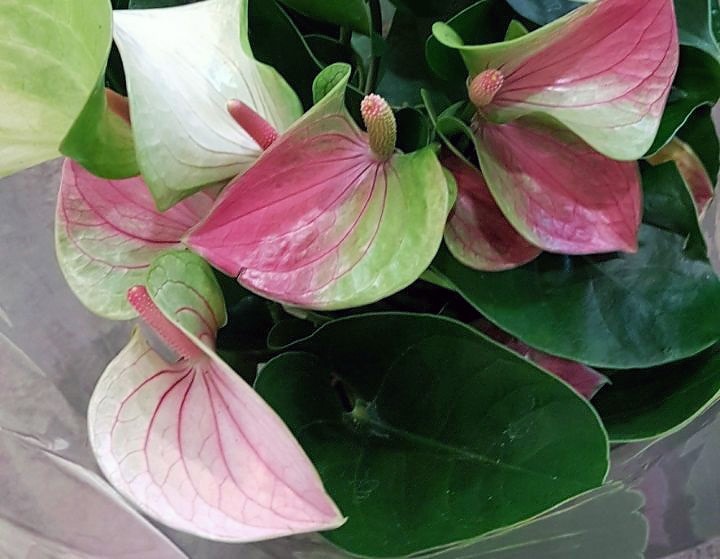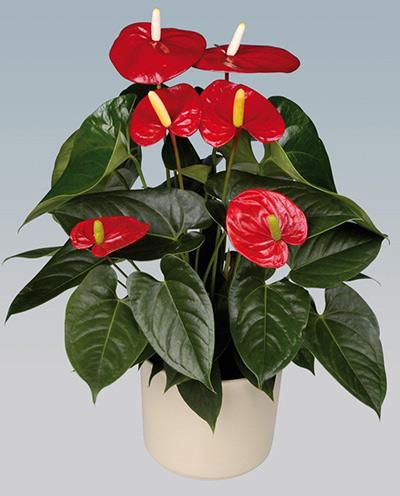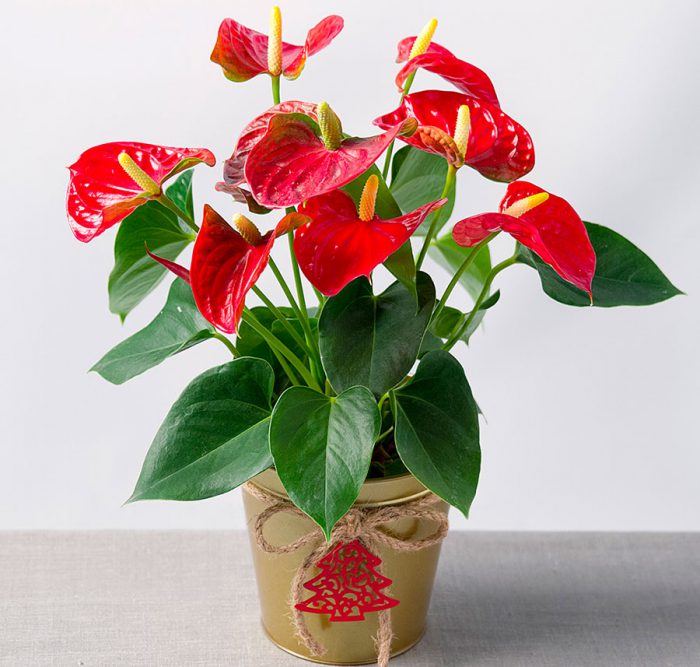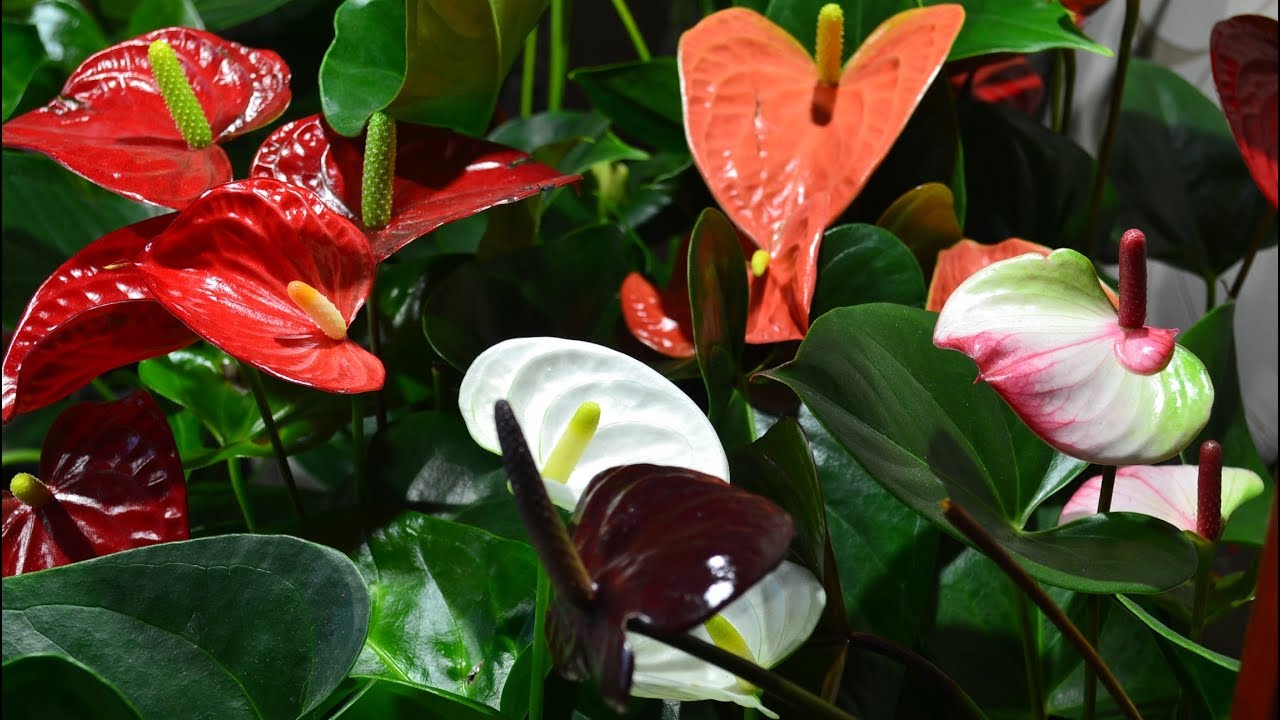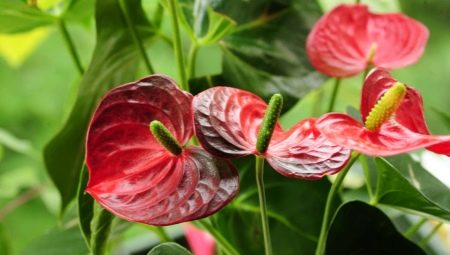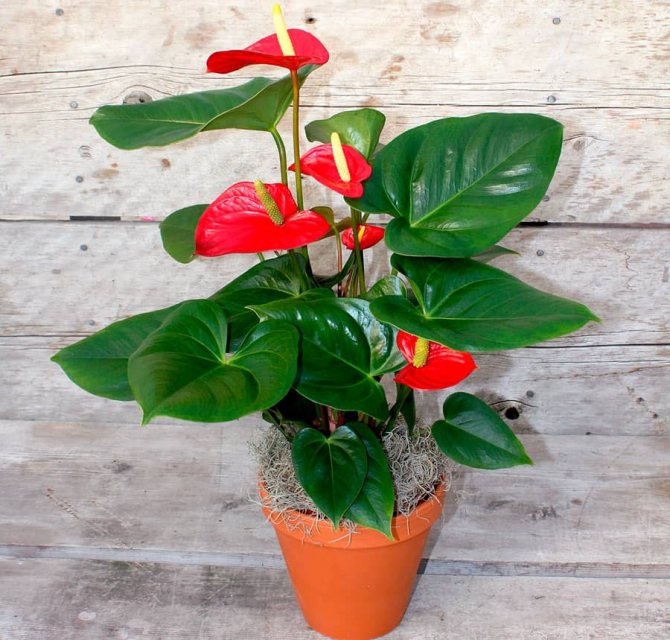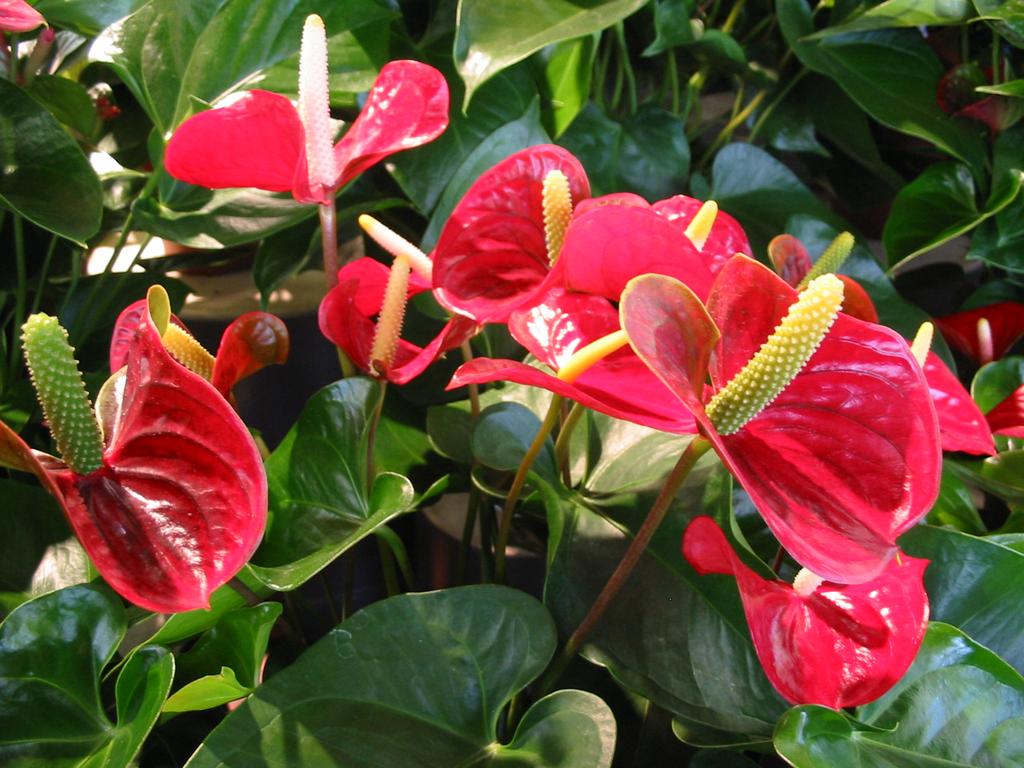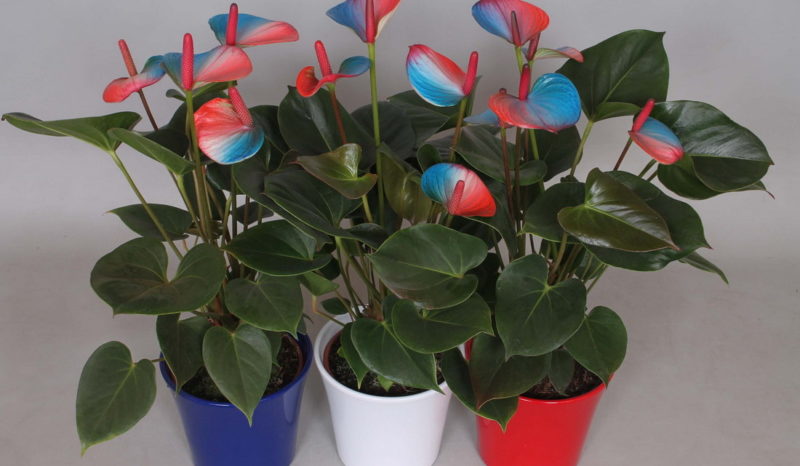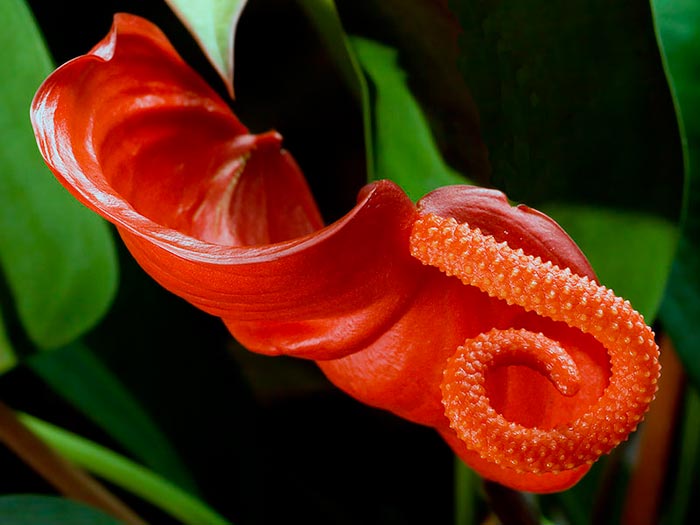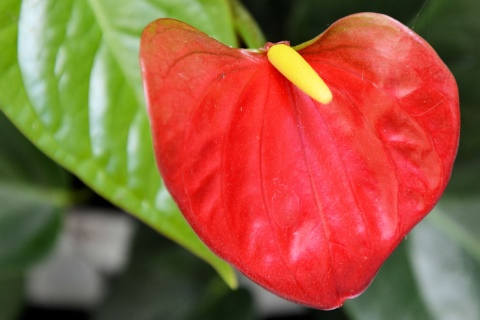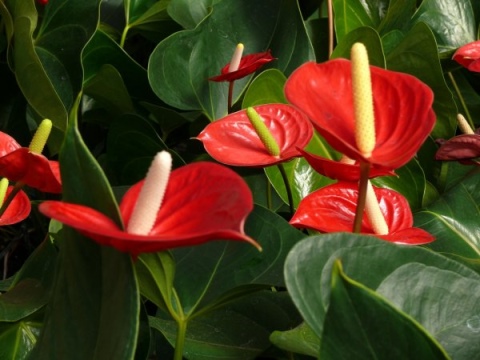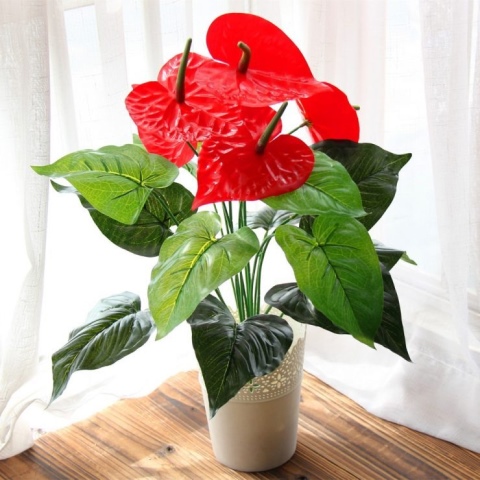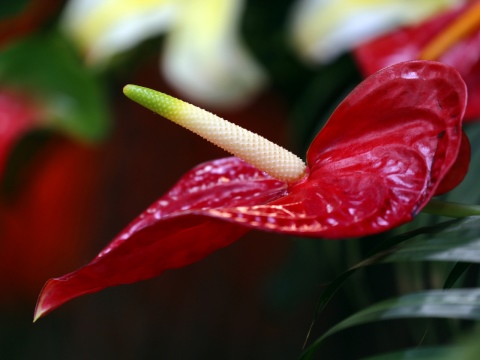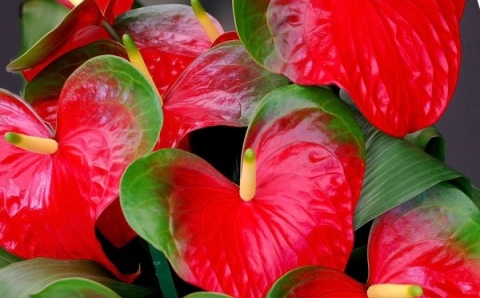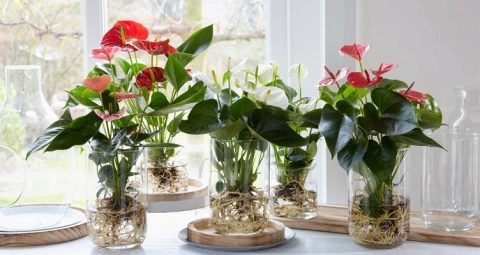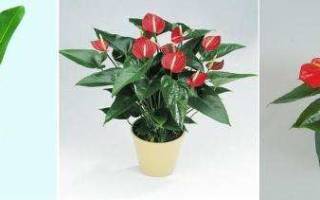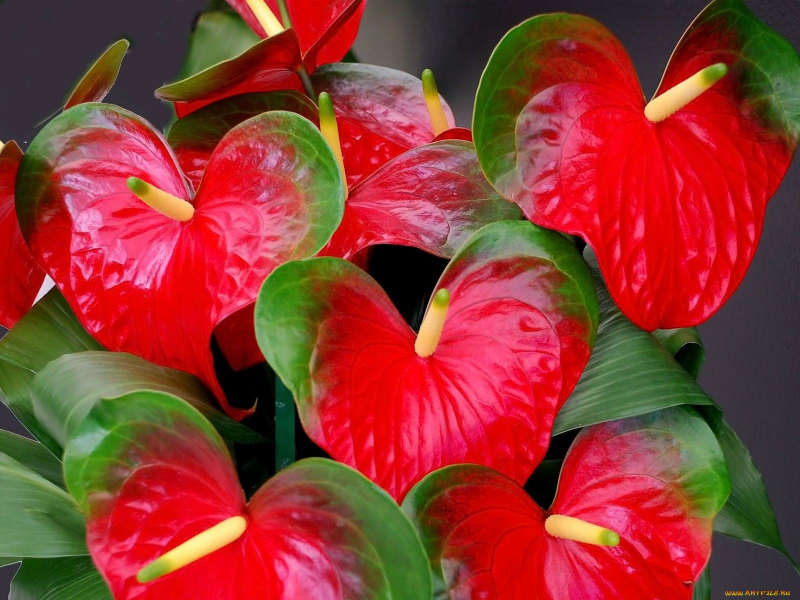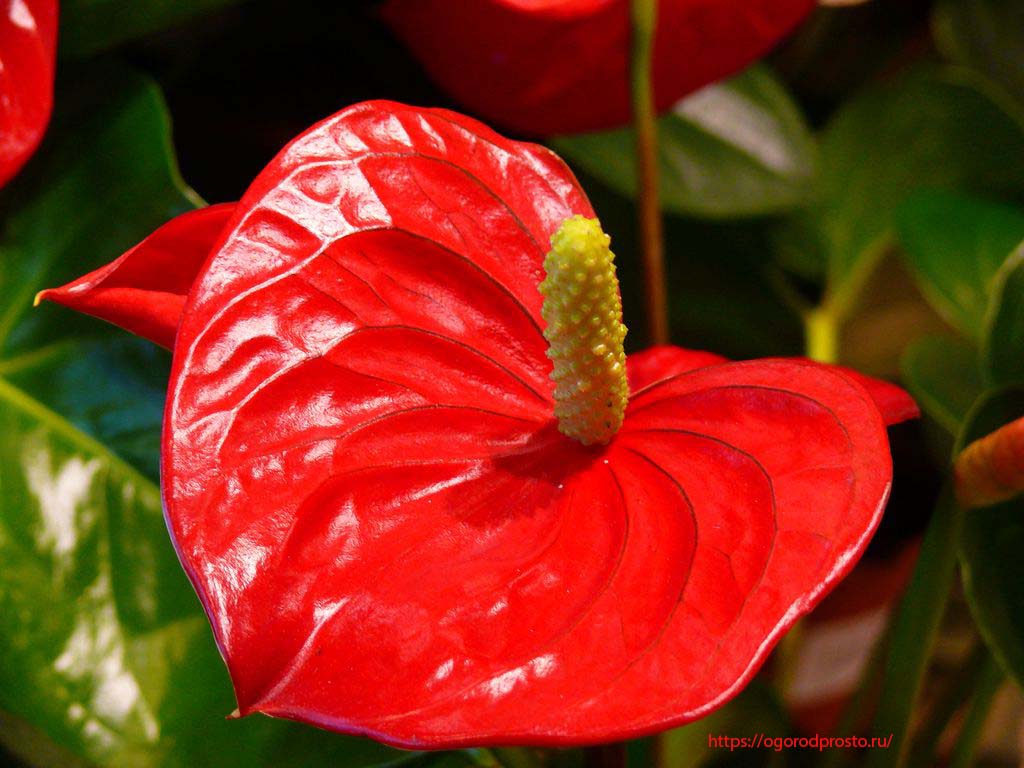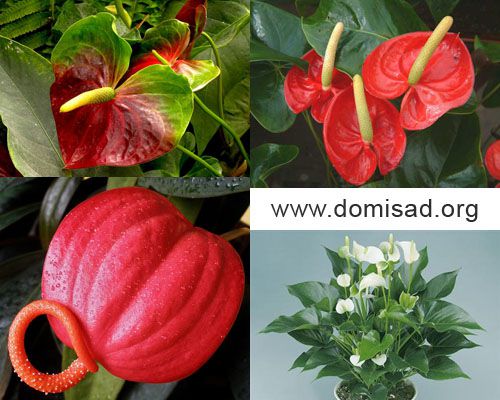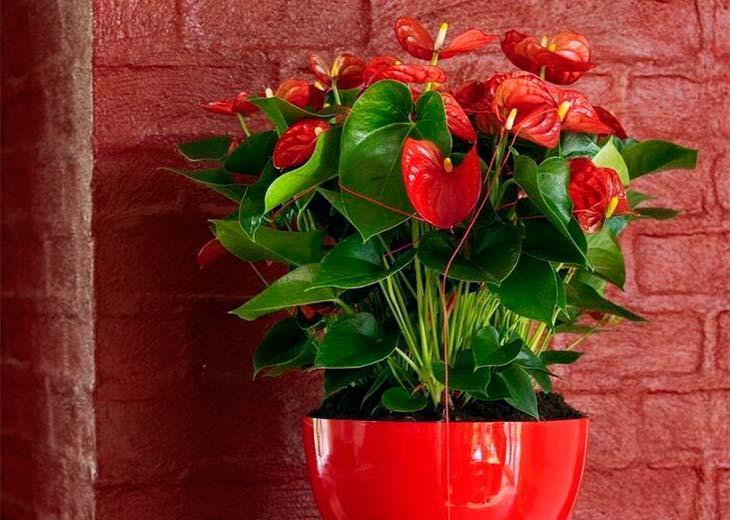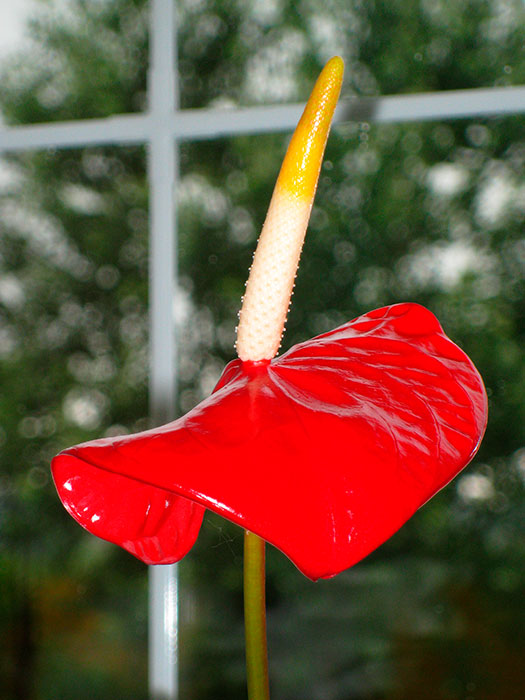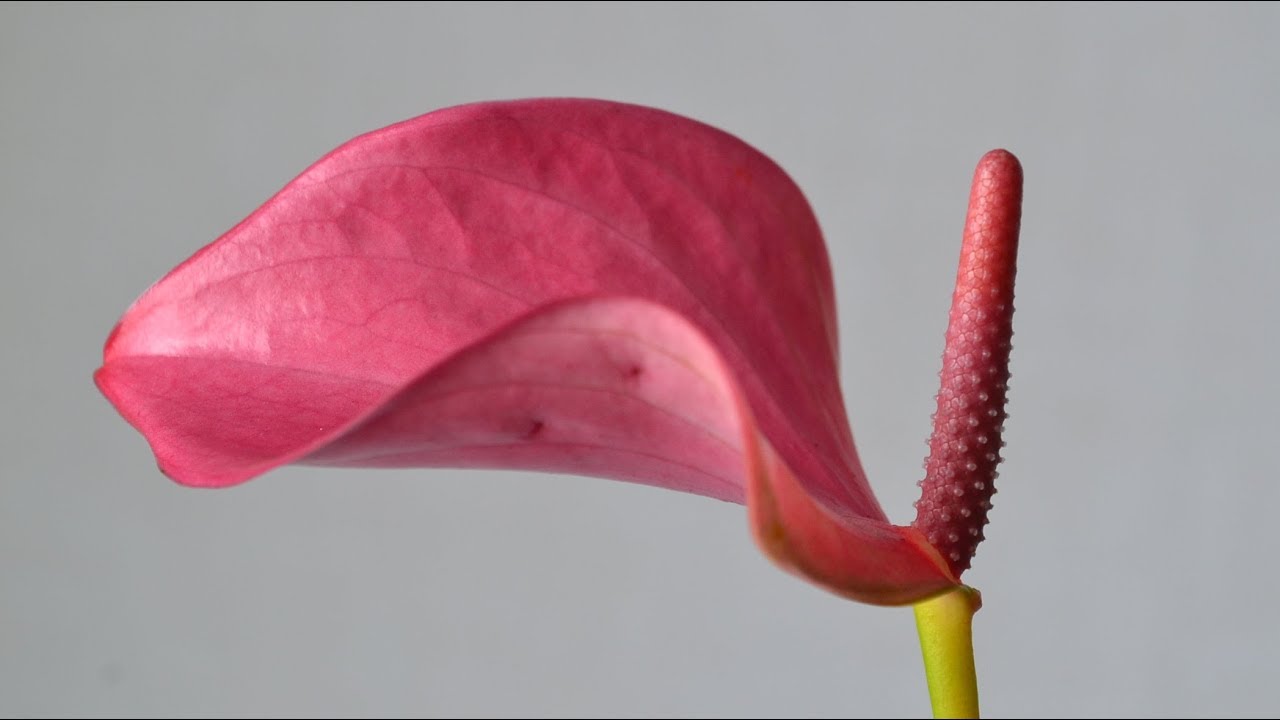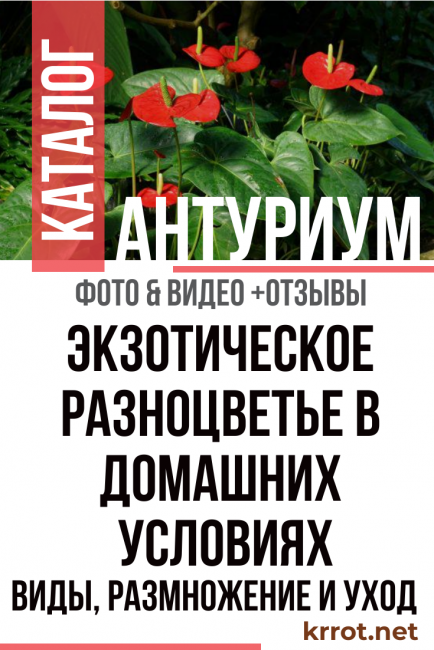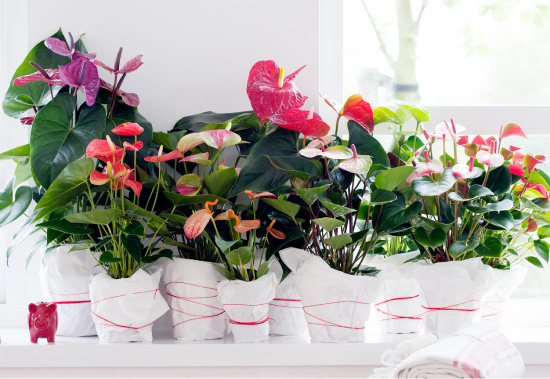Morphological description
Anthurium belongs to herbaceous evergreen crops. There are climbing species and treelike ones. Basically, all flowers of this type are epiphytes. They grow on trees and have an aerial root system. Found among anthuriums and semi-epiphytes. These are crops growing from seeds and located in the upper tier of the forest. Subsequently, as they develop, aerial roots are formed in them, and they become epiphytes.

Occurs among anthurium and lithophytes, entering into symbiotic relationships with ants. Savannah crops have a reduced stem. A narrow plate that is rough and thick to the touch. The petiole of such a plant is short. At its base, aerial roots are formed, their ends are directed upwards and are covered with velamen.
Anthurium has thick stems. There are varieties with shortened internodes and elongated stems. The standard plant stem length is around 15-30 cm.
Leaves, depending on the variety, have a varied shape: rounded, with a blunt apex, spatulate, dissected. The petioles are equipped with a geniculum. Leaves are found at the end of a thick stem. Can be assembled into an outlet or grown vertically. They reach a length of 100–118 cm. Their surface is matte, glossy or semi-glossy. The structure of the leaves is different - from fragile to dense leathery.
Flowers are able to turn in the wake of the sun. In a dry environment, a rosette is created that resembles a bird's nest. It accumulates plant residues that absorb moisture. Due to this, the plant receives a natural fertilizer rich in nutrients.
Most terrestrial species have heart-shaped leaves. There are grapevine-like creeping varieties of anthuriums. On such plants, lanceolate leaves grow, collected in rosettes. There are varieties with multi-feather foliage.
The inflorescence of the plant is white, green or bright, colored purple, red or pink. There is a multi-colored one. The cover of the inflorescence is leathery in structure. During the growth and development of the plant, the shade of the bedspread can change from light to darker and more saturated.
The inflorescence is an ear. Its shape can be:
- conical;
- spherical;
- spiral;
- clavate.
The color of the inflorescence is white, red, purple, green, pink. Colors from a combination of these shades can be observed. The flowers are densely on the cob, in series of spirals. Somewhat reminiscent of squares and rhombuses. Bisexual. Equipped with a four-membered perianth.
Anthurium blooms in a special way. During the female phase, only stigmas are visible on flowers. At this time, the stamens are hidden deep in the perianth. Drops of viscous liquid appear on the stigmas. As soon as the liquid dries up, the stigma begins not to perceive the pollen, and stamens appear around the perianth. Gradually, as they develop, they retract and completely cover the stigma. The duration of flowering of this culture can last up to several weeks.
Anthurium flowers smell strong. Moreover, depending on the variety, the aroma can be either pleasant or fetid.
The fruits of the plant are fleshy and juicy. They are berries containing a large number of seeds. The shade of the berries can range from deep red to black. There are bicolor and striped berries. Seeds are flat-convex. When ripe, the berry is squeezed out of the perianth and hangs down in two strips resembling threads that are attached to the perianth.
How anthurium reproduces
Owners of blooming anthurium often face the risk of disease or death of the plant in the absence of proper care or infection. It is better to take care of the multiplication of culture in time. Additional specimens are obtained by dividing the bush, germinating seeds, grafting, and forming air layers.

Breeding anthurium at home
Germinating seeds
The need to grow anthurium from seeds appears under the following conditions:
- Getting a lot of young plants.
- Sowing seeds received by mail or provided by other growers.
- With the purposeful cultivation of seeds of two pre-selected parents.
Note! The seeds on the pet's inflorescences will not tie on their own. In nature, the flower is pollinated by insects attracted by the pronounced aroma of the plant.
There are no pollinators in the apartment. Gardeners recommend smearing various "cobs" with a soft brush during the week. Anthurium flowers reach sexual maturity for a long period. In individual inflorescences, pistils and stamens are usually ready for pollination on different days. The best time for pollination is sunny days.
In nature, the flower is pollinated by insects attracted by the pronounced aroma of the plant. There are no pollinators in the apartment. Gardeners recommend smearing various "cobs" with a soft brush during the week. Anthurium flowers reach sexual maturity for a long period. In individual inflorescences, pistils and stamens are usually ready for pollination on different days. The best time for pollination is sunny days.
Ripening of berries on inflorescences lasts 8 months. Seeds are formed inside the fruit. The berry ripening signal is its separation from the flower. The seeds are separated from the pulp, kept in pink potassium permanganate, slightly dried at room temperature.
Anthuriums are sown in spacious shallow tanks. The landing stages are not difficult, it is enough:
- Fill the container with soil mixture, moisten the earth.
- Spread the seeds over the soil.
- Press the sowing lightly into the substrate;
- Close the tank with glass or polyethylene;
- Place the reservoir in a warm, bright place.
If the seeds are planted correctly and the room temperature is maintained at 22 degrees, the first shoots will appear after a week, mass germination will begin in 14 days.
Rooting cuttings
The ideal time for rooting anthurium cuttings falls from April to June. Shoots 12 cm long with aerial roots and two healthy leaves are suitable for reproduction. Before planting, the leaves are removed or twisted into a tube, tied with a thread, preventing excessive evaporation of moisture. Slices on the handle are treated with activated carbon. The shoots are immersed in the substrate 5 cm, watered and covered with a film to form a greenhouse effect. The temperature in the greenhouse is maintained close to + 21-24 degrees, sprayed and ventilated daily, the substrate is moistened.
On a note. If the new seedlings began to release green leaves, the rooting of the cuttings was as successful as possible. The young plant is ready to be transplanted to a permanent location.
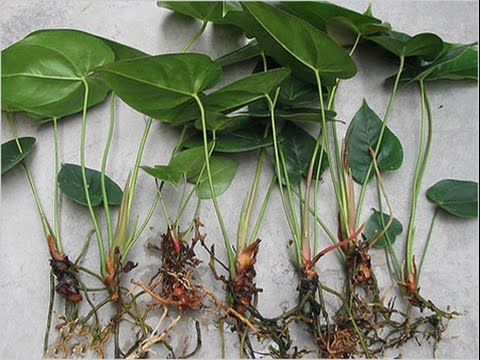
Reproduction of anthurium at home by cuttings
Air layering
If the plant stretches and loses its shape, the upper shoot is convenient to use for reproduction of anthurium. You will need to free part of the top from dried scales and leaves, wrap it with wet peat moss.
Fasten a bag or film over the bandage. After a certain time, new roots will begin to penetrate the moss. The cutting from the anthurium is cut and rooted in a separate container. The remaining stem will quickly grow lateral shoots.
Division of roots
Reproduction by dividing the roots is convenient to carry out during the spring transplant of anthuriums into new flowerpots. The step-by-step instruction of the process includes a number of stages:
- An adult bush is carefully removed from the pot, shaken off the soil, and the root system is freed.
- The roots are untwisted and divided equally with a sharp, clean knife.
- Root cuts and breaks are disinfected with activated carbon.
Important! Separated flower parts are planted separately
Flower indoor anthurium care. Male flower anthurium how to care
Florists consider the plant to be quite delicate, since in order for it to feel comfortable and grow well, it needs careful care. For this, the owners of the flower will have to work hard to create conditions for it close to tropical. The humidity in the room should be elevated, the temperature should also correspond to the tropical climate, and the sun's rays should not directly hit the plant.
Varieties of male happiness
In the plant classification, it is already possible to consider about 800 subspecies, among which there may be epiphytes and semi-epiphytes, which have a lot of differences between themselves.
You cannot grow many of the species on the windowsill, because they will need greenhouse conditions.
The types that you can enjoy in the apartment and grow without unnecessary hassle and emerging problems:
- Andre
- Crystal
- Scherzer
The first presented type is the most common among lovers of original indoor flowers. It contains the largest palette of colors, colors and shades of a heart-shaped bedspread.
Anthurium Andre male happiness (A. Andreanum)
The leaves of this variety are brilliant, deep green in color. The height can be up to one meter. The flower has one large heart-shaped petal and is unusually shiny.
 Within the varieties of Anthurium Andre
Within the varieties of Anthurium Andre
Red varieties of anthuriums
- Arizona
- Dakota is the most sought after species
- Purple Love reddish purple
- Belize
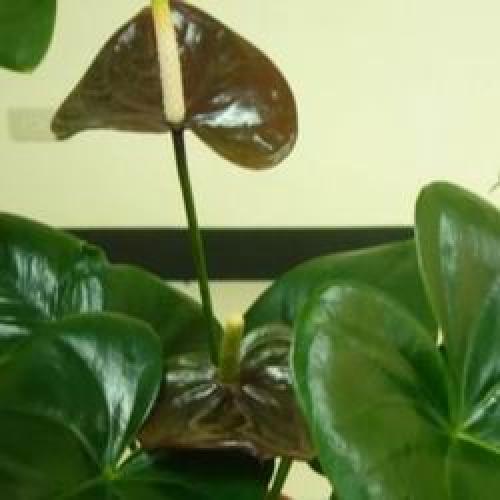 Black anthurium, the most exotic and unusual species. It is characterized by dark red buds, and in full bloom become black cherry, varieties:
Black anthurium, the most exotic and unusual species. It is characterized by dark red buds, and in full bloom become black cherry, varieties:
- Black Queen
- Black Prince
- Choco with chocolate buds
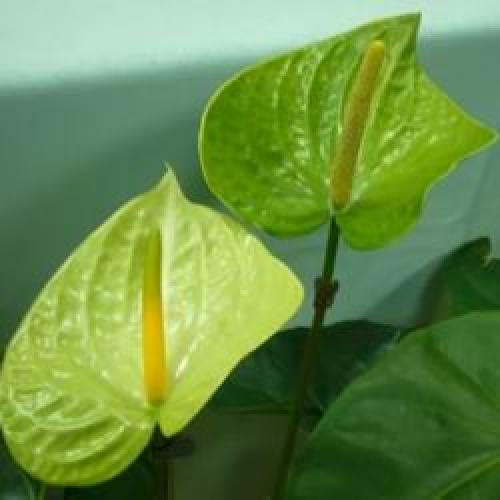 Green anthurium, very unusual, with flowers and leaves of the same color, differing in different shades. The most interesting and frequently met:
Green anthurium, very unusual, with flowers and leaves of the same color, differing in different shades. The most interesting and frequently met:
- Manaka
- Midori
- Green King
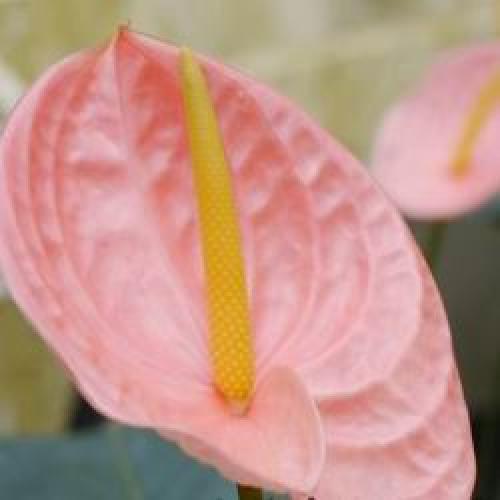 Pink anthurium, with delicate and fragile inflorescences, against a background of dark green waxy foliage.
Pink anthurium, with delicate and fragile inflorescences, against a background of dark green waxy foliage.
- Olfers
- Pink Champion
- Lindsen
- Amis
- Cheers
- Minnesota (Minnesota) with pinkish salmon large flowers
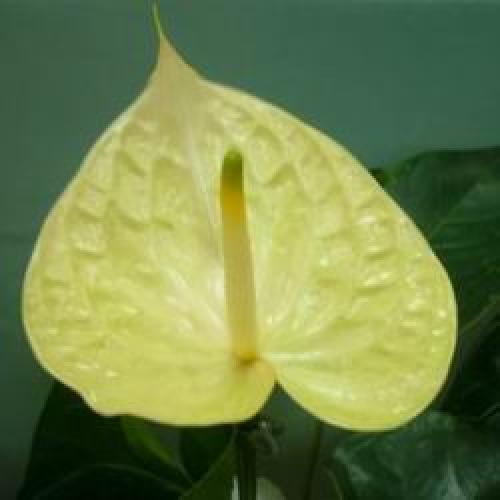 White, with virgin light inflorescences and green waxy leaves. Looks like spathiphyllum due to color. It is believed that white anthurium female happiness attracts to its owner.
White, with virgin light inflorescences and green waxy leaves. Looks like spathiphyllum due to color. It is believed that white anthurium female happiness attracts to its owner.
- Acropolis
- Champion
- Polaris
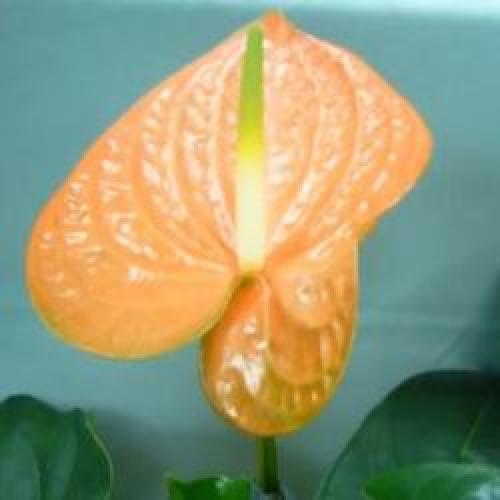 Anthurium yellow is called so, quite a stretch, since it has varieties with a color not purely yellow, but rather orange-red
Anthurium yellow is called so, quite a stretch, since it has varieties with a color not purely yellow, but rather orange-red
- Marasol
- Princess Orange
- Avento
- Princess Alexia lemon yellow
- Casino
 Exotic colors of the variety:
Exotic colors of the variety:
- Purple - Sensa
- Purple - Princess Amalia
- Lilac anthurium
- Princess Alexia Blue - Sky Blue
- Picasso Blue bluish blue
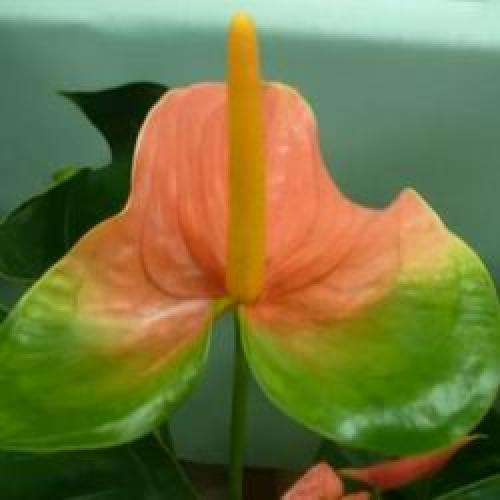 Two-color anthurium:
Two-color anthurium:
- Baby Boomer is colored green-red, a little orange at the transition
- Princess Amalia Elegance light pink with a light green transition to the base
- Whitish jade - light green
- Amalia Hot Lips (Hot Lips) salmon light green color, gives an elusive charm to blossoming delicate inflorescences that sway on graceful legs
Crystal (A. Cristallinum)
This type of plant belongs to decorative deciduous. It looks effective thanks to its dark green velvety foliage, on which a silvery mesh of veins is formed.
Scherzer (A. Scherzerianum)
Epiphyte, whose shoots are shortened and endowed with matte leaves decorated with black spots. The ear is spiral-shaped. The flower can grow up to 30 cm. The bedspread is colored orange-red, while the ear is orange or yellow. This species is easiest to grow at home.
To beautify the premises and give them an original look, they purchase a variety of Hooker, Baker, five-leaf, climbing or others.
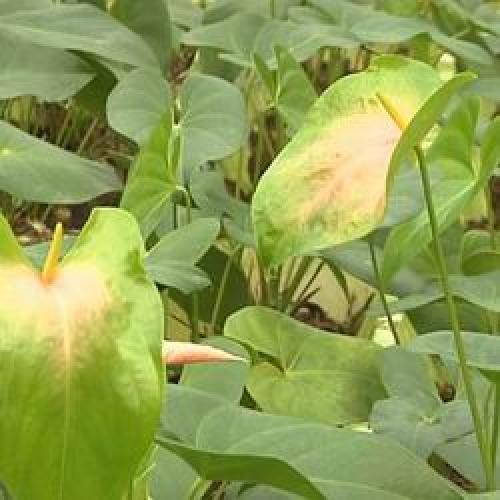
 The most recognizable among all plants are variegated varieties, which have a lot of similarities to each other.All of them are short in stature with large dark green leaves, on which velvet white veins are visible.
The most recognizable among all plants are variegated varieties, which have a lot of similarities to each other.All of them are short in stature with large dark green leaves, on which velvet white veins are visible.
The only difference is the leaf petiole. The majestic anthurium (A. Magnificum) consists of a tetrahedral, while the crystal has a round shape.
Decorative flowering species of anthurium and their varieties and hybrids
To grow a beautiful ornamental plant with large flowers at home, it needs to be provided with full and high-quality care.
Anthurium Andre (andrianum)
It is an evergreen herb that reaches 1 m in height. It is also called Andrianum. Ecuador and Colombia are considered the birthplace of culture. The leaves are dark green in color. Yellow buds are collected in 1 ear and surrounded by a blanket
Scherzer's Anthurium
This is a very unpretentious culture. The plant is small. Therefore, it is customary to refer it to dwarf anthuriums. The variety is characterized by a curved inflorescence of orange color. The bedspread has a deep red hue, and the leaves are green.
Anthurium mix
Under anthurium mix understand a mixture of varieties of one or a variety of species. Thanks to crossing, it is possible to get different colors - white or burgundy.
Amalia Elegance
This is a very beautiful cultivated plant. Princess Amalia Elegance has a striking white and pink bracts. In this case, the inflorescence has a red tint.
Amalia Purple
Anthurium variety Amalia Purpl has a spectacular purple color. The leaves have a dark green tint and a pointed end. The Amalia Purple plant is small in size and reaches 20-30 cm in height.
Picasso
This variety is distinguished by an unevenly colored orange bedspread. It is characterized by a spectacular red-orange inflorescence.
Eleanor
Anthurium Eleanor is characterized by spectacular inflorescences and decorative dark green leaves. That is why the variety is chosen by many growers.
Otazu Brown
This flower has a maroon, almost chocolate color of the bract. It has an unusual appearance.
Dakota
The Dakota variety is a bushy plant with a height of 80 cm. They are characterized by a straight ear of a yellow hue and a large glossy bedspread. The flower color can be pink or red.
Turense
This variety is characterized by decorative glossy leaves. It is a lush bush. The bract has an intense red tint, and the ear has a rich yellow color. The bush reaches 50 cm in height.
Pink champion
This variety is characterized by a rather lush bush. The ears are yellow or greenish in color. The wide-heart bracts have a pink tint.
Baby boomer
This hybrid variety is characterized by a two-tone shade of the bedspread. The plate has a red tint. An exception is the green base. The ear has a straight shape, and the leaves have a pointed end.
Baby Boomer is a popular variety with a two-tone bedspread
Leganza
It is a highly leafy variety that has a yellow ear. Subsequently, it acquires a bright carrot color.
Note! The bract may have a coral shade with a green border
Fiorino
In the description of the Fiorino anthurium, it is said that the bracts have a noble purple color. It is characterized by a lilac undertone.
Fantasy love
This is a fairly large crop that has variegated inflorescences. As the bedspread unfolds, white and pink flowers appear. In adult plants, the white areas turn green.
Important! The plant needs diffused lighting. In partial shade, the culture begins to wither rapidly
Pandora
The variety called Pandora is characterized by compact bushes with small leaves and long petioles. The plant is decorated with creamy inflorescences with a pale pink bracts.
The plant has delicate pink inflorescences
Sierra Magic
This compact plant has many small flowers. The ears are yellow in color and have a white tip. The bedspread is red, white or pink.
Types and varieties of anthurium
Among the enormous wealth of representatives of the genus, only a few species are considered the most adapted to growing in indoor conditions.
As a result of selection, they presented gardeners with hundreds of varieties and hybrids with often unusual shapes and colors of covers, which can be of different shades of white, pink, green, red, bronze with specks and without, as well as colors that are completely exclusive for these plants - yellow and purple.
Anthurium Andreanum and its hybrids are currently the most popular houseplant with red, purple, pink, yellow or white leathery petals with well-defined veins.
Anthurium Andreanum
Almost all flowers that you see in a flower shop will be varieties of this species. The plant can reach 100 cm in length.
The flowers are large - the length of the bedspread is 20 cm, and the width is 18 cm. The leaves in the shape of a heart, depending on the variety, can be green or variegated. It blooms in spring and summer.
Varieties of this type:
"Acropolis" and "Fantasy" - a variety with a white blanket against a background of green glossy leaves, "Carré" in a pink shade, spectacular "Crimson Love", "Fantasy Love" with unusual light green-pink petals, delicate lilac-purple "Fiorino".
Anthurium Andreanum cultivar Fantasy Love
Anthurium scherzerianum Schott. A rather unpretentious look, the height of the peduncles of which is 20-50 cm.The leaves are dark green oblong, elliptical or lanceolate, the length may exceed 20 cm.
Orange or orange-red inflorescence - the ear is slightly twisted in a spiral, which is characteristic of this particular species. The bedspread is bright, of all shades of red, in some varieties it is creamy with red spots.
Anthurium scherzerianum
Sorts: "Solnechny", "Arabella", white with a motley red scattering "Stephanie", "Tessa", "Artus", "Amaretti" with a light orange blanket and a scattering of specks.
Anthurium crystal (Anthurium crystallinum). It is characterized by very decorative, heart-shaped green leaves with a velvety covering, on which light veins are clearly visible.
Anthurium crystallinum
Greenish fragrant buds-cobs with a small green veil are inconspicuous, so the species is grown exclusively because of the spectacular foliage, which has an unusual crystal luster.
Majestic (Anthurium magnificum Lind). This decorative leafy species is similar to the Khrustalny anthurium, but it is distinguished by its rapid growth and the shape of a tetrahedral petiole.
Anthurium magnificum
Its large, gorgeous dark green leaves have a velvety texture and can be bi-colored with silvery lines along the main veins. These lines give the foliage a dramatic shine. The bedspread is green, re-curved. The ear is yellow-green.
Anthurium hookeri, also called "bird's nest", is a rather rare cultivated variety with large leaves with light veins, the length of which in the natural environment can reach 80 cm. Flowers are pale lilac, but blooms not often.
Anthurium veitchii. The huge, corrugated leaves are the main decorative element of the native of Colombia. This is a rare plant for true collectors and experienced florists.
Male indoor flower anthurium. Problems, diseases of anthurium and their treatment
Indoor flower "man's happiness" is also susceptible to disease. It can be attacked by pests or serious diseases, which are eliminated by spraying with special compounds designed to eliminate a certain ailment of anthurium.
In most cases, the culprit for the development of diseases is improper care of the plant, which should be considered in more detail.

Why does not anthurium bloom at home?
As mentioned above, anthurium does not bloom due to excessive watering and stagnant moisture in the soil. But often the restoration of the water balance did not improve the situation. Then you should consider several other reasons for the lack of flowering.
Pay attention to this material - Spathiphyllum: home care (flower of female happiness). There are reasons such as:
There are reasons such as:
Low room temperature during possible bud break. Most varieties require an optimal flowering temperature of at least 22 degrees Celsius.If this requirement is not met, the beginning of flowering can not be expected.
Being in the shade provokes a lack of natural sunlight. If it is not possible to install a flowerpot in a brighter part of the room, use additional artificial lighting.
It is important for anthurium to winter in an atmosphere suitable for this. The optimum temperature during the dormant period of the plant should not go beyond 15-18 degrees Celsius.
The presence of buds that have already completed their flowering. Once the buds have bloomed, the seed formation process takes place. This requires its own conditions, for example, the daily intake of moisture, heat and light. As a result, the process takes away nutrients from the entire plant, which opposes the beginning of flowering. Therefore, immediately after flowering, trim the buds with scissors.
Take a closer look at your flower, perhaps one of the listed factors is taking place. Then bring the plant to the species required for flowering and carry out all the procedures according to the instructions given.
You will be interested in this article - Zamioculcas (dollar tree): home care.

Why do anthurium leaves turn yellow at the edge?
The yellowness of the leaves of anthurium along the edge is found in most cases in winter. This is due to the lack of natural light, which must be eliminated by using additional lighting fixtures.
Sometimes the leaves of the plant turn yellow at the edges if direct sunlight is directed at them. Then you should remove the flowerpot with a flower away from the window opening. It is better in this case to place the pot in a corner with a little shading.
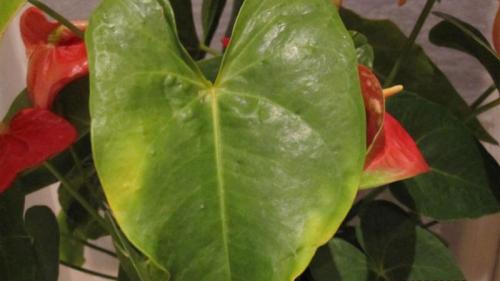
Also, under the influence of sunlight, plant leaves can get burned if water gets on them during watering, and the flowerpot itself is installed on a windowsill under the scorching sun.
History
The legend of the origin of the flower dates back to India. At that time, the world was ruled by cruelty, greed. People were divided into tribes, and heartless leaders ruled over all.
The leader of one of the tribes was passing by the neighbors, where he saw a young, beautiful girl. He decided to take the person as his wife.
The girl was against the wedding with the leader and rejected the guy. He decided to go to war against her tribe and take her by force.
When he overcame the tribe and the wedding day came, the soldiers kindled a holiday fire. The young lady did not want to be imprisoned in the bonds of marriage with the unloved. The girl decided to commit suicide by jumping into the fire, dressed in a beautiful red dress.
Red Anthurium Care
An exotic rainforest plant requires some attention and care. In return, it will generously endow it with a beautiful view and long flowering.
Watering
Anthurium should be watered as the earthen coma dries. More often in summer, less often in winter. Water for irrigation should be taken soft, warm, settled. The plant needs spraying in hot summer weather. Care must be taken to prevent water droplets from falling on flowers and leaves.

Fertilizer
As a top dressing, complex mineral and organic fertilizers in liquid form are applied once every 2-3 weeks. When transplanting, you can add fermented manure and chopped dry leaves.
Reproduction
Red Anthurium propagates by cuttings, shoots, division and seeds. The seed method is the most laborious and time consuming, therefore it is used extremely rarely.
Most often, cuttings and division of the bush are used when transplanting. To do this, take a stalk or leaf with a stem and place it in water, where it releases roots, after which the stalk with roots is planted in prepared soil and covered with a film.
Diseases and pests
In case of violation of the temperature regime and waterlogging of the soil, Red Anthurium affects stem and root rot. The disease manifests itself in the drying of the leaves at the edges. It is urgent to eliminate the cause and transplant the plant, otherwise it may die.
Among insect pests, Red Anthurium can attack aphids, scale insects, thrips, mealybugs, and root nematodes.
At first, folk remedies will help to cope with them - wiping the leaves with a solution of laundry soap and infusion of tobacco. But if folk remedies are powerless, they apply the appropriate insecticides twice.
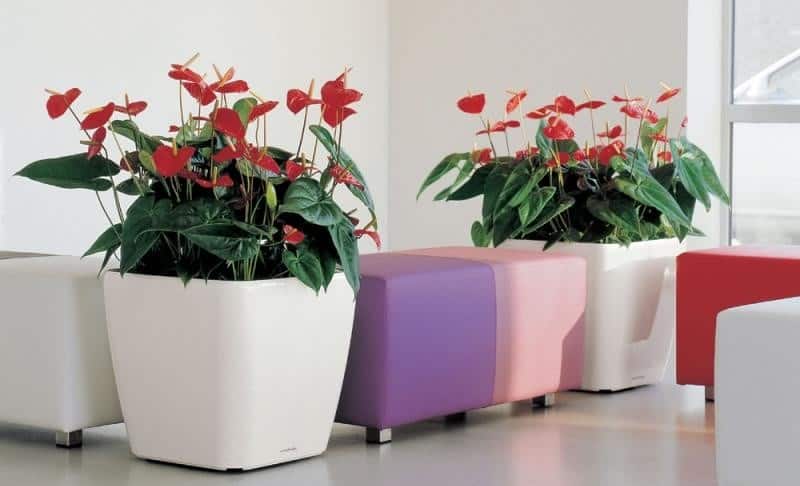
Possible problems when growing Red Anthurium
Sometimes, with improper care, the following signs of plant unhealthy may occur:
- Leaves at the ends turn black. This happens when there is an excess of calcium in the soil. It is necessary to transplant the plant into suitable soil.
- Leaves curl. This is facilitated by overdried air, drafts, and insufficient illumination. It is necessary to analyze the reason and change the conditions of detention.
Anthurium - what is this flower
The flower belongs to the Aroid family. More than 900 plant species are included in this category. Moreover, half of them were obtained artificially. Under natural conditions, the culture is found in South and Central America. It also grows in the Caribbean.
The plant is characterized by attractive flowers
Botanical description
The plant has excellent decorative properties. This is due to the presence of evergreen leaves that have a leathery structure. They differ in shape - they are solid, deeply dissected, incised. The color of the foliage also varies. There are leaves with a velvety sheen, glossy sheen, silvery veins on a green background.
The main advantage of such plants is beautiful flowers. They are small in size and form long cobs. Around each of them there is a bracts - a veil. Its size and color depend on the anthurium variety.
Important! The surface of the bracts can be glossy or matte. After the end of flowering, fruits resembling berries appear on the plant
The plant has excellent decorative properties.
Useful and dangerous properties of the plant
Growing a culture at home helps to achieve the following results:
- reduce the content of microbes in the air by 70%;
- purify the air from formaldehyde by 8%;
- clean the room from toluene and ammonia.
Important! The culture is considered poisonous, therefore, if ingested, it can provoke poisoning. It is especially important to supervise children and animals
What is the difference between anthurium and spathiphyllum
These plants differ in appearance. Spathiphyllum is characterized by a white veil, which is similar in shape to the oval or lanceolate leaves of the culture.
Anthurium has a wide-hearted and glossy base. In this case, the foliage has a deep heart-shaped base. The color of the bedspread can be different - white, pink, orange. However, the most common option is red.
Diseases and pests of Pink Anthurium
As a rule, anthurium in indoor conditions is unpretentious and grows well. But sometimes the appearance of the flower tells the owner that something is wrong with the pet. The most common problem is yellowed leaves. This happens due to:
- insufficient watering;
- sunburn;
- the development of chlorosis (the leaf is yellow, and the veins are green);
- defeat by fungi (soot, soil or powdery mildew);
- excessively low air temperature.
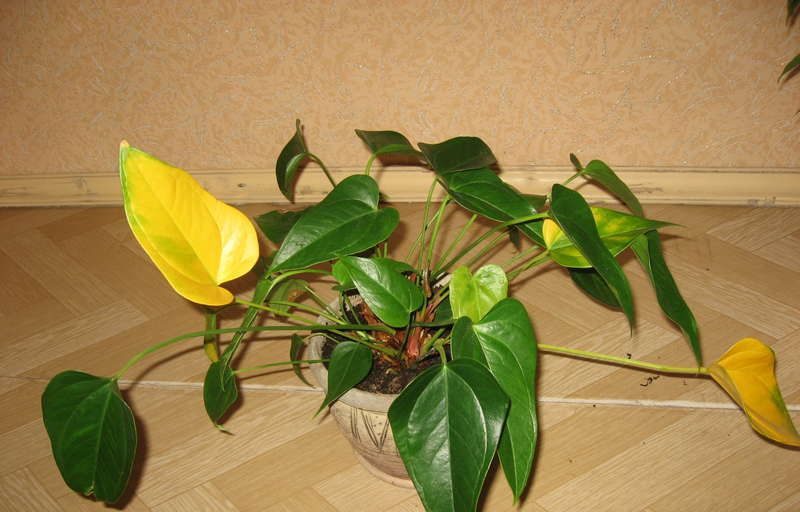
Yellowing of anthurium leaves
If the reason for the yellowing is improper care, creating the right conditions will help restore the pet's health. Chlorosis can be fought with iron chelate (spray on a diseased plant). Fungicides or potassium soap will help get rid of fungal diseases, and you will also have to adjust watering and room temperature. By the way, fungi can also cause blackening of foliage. As a rule, this happens against the background of rotting roots. Blackened greens of anthurium can also be a signal of improper watering (the water is too cold or hard).
Anthurium does not tolerate and proximity to some insects. He quickly reacts to "tenants" with yellowing. The most dangerous for him are spider mites, thrips, scale insects and aphids. Insecticides will help you get rid of unwanted neighbors.

